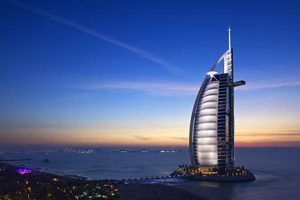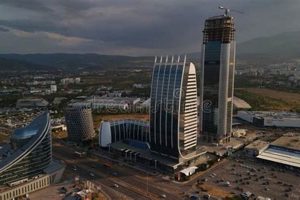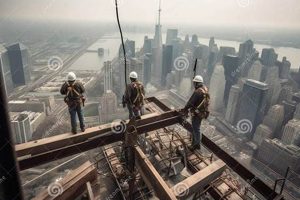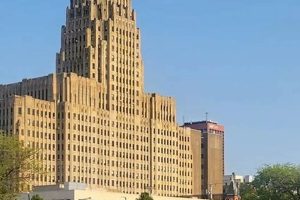Singapore skyscrapers are a defining feature of the city’s skyline, symbolizing its economic prosperity and architectural prowess. A skyscraper is a tall, multi-story building, typically made of steel and glass. Singapore’s skyscrapers are known for their innovative design, eco-friendly features, and breathtaking views.
One of the most iconic skyscrapers in Singapore is the Marina Bay Sands. This integrated resort complex features three 55-story towers connected by a Sands SkyPark, which offers panoramic views of the city. Another notable skyscraper is the One Raffles Place, which was once the tallest building in Singapore. It is known for its distinctive triangular shape and its use of natural ventilation to reduce energy consumption.
Singapore’s skyscrapers are not just architectural marvels; they also play a significant role in the city’s economy. They house offices, hotels, and retail spaces, contributing to Singapore’s position as a global financial and business hub. The skyscrapers also attract tourists from around the world, who come to admire their beauty and experience the city’s vibrant atmosphere.
1. Height
The height of Singapore skyscrapers is a testament to the city’s ambition and economic prowess. In a relatively small country with limited land area, building tall has been a strategic move to maximize space and create a vertical city.
- Engineering feats: Constructing skyscrapers over 200 meters tall requires advanced engineering techniques and innovative structural designs. Singapore’s skyscrapers showcase the expertise and capabilities of the city’s architects and engineers.
- Iconic landmarks: The height of Singapore skyscrapers makes them iconic landmarks that define the city’s skyline. Buildings like the Marina Bay Sands and the One Raffles Place are instantly recognizable symbols of Singapore.
- Economic drivers: Tall skyscrapers can accommodate more businesses and workers, contributing to Singapore’s economic growth. They attract multinational corporations and create a vibrant business environment.
- Vertical living: Singapore’s tall skyscrapers offer a unique form of vertical living, where residents can enjoy stunning views and convenient access to amenities within the building complex.
The height of Singapore skyscrapers is not just about aesthetics; it is a reflection of the city’s ambition, innovation, and economic success. These towering structures are more than just buildings; they are symbols of Singapore’s progress and prosperity.
2. Design
The design of Singapore skyscrapers is a harmonious blend of innovation and tradition, reflecting the city’s unique identity and cultural heritage. Architects have skillfully incorporated elements of traditional Southeast Asian architecture with modern design principles to create skyscrapers that are both visually stunning and culturally significant.
- Contemporary aesthetics: Singapore skyscrapers showcase a wide range of contemporary architectural styles, from sleek and minimalist to bold and futuristic. The use of glass, steel, and other modern materials gives these buildings a distinctly urban and cosmopolitan look.
- Cultural influences: Many Singapore skyscrapers incorporate design elements inspired by traditional Malay, Chinese, and Indian architecture. This can be seen in the use of intricate patterns, vibrant colors, and symbolic motifs, which add a touch of local character to these modern structures.
- Sustainability: Singapore skyscrapers are not just design marvels; they are also designed with sustainability in mind. Many buildings feature green roofs, rainwater harvesting systems, and energy-efficient lighting to minimize their environmental impact.
- Functionality: Despite their impressive heights, Singapore skyscrapers are designed to be highly functional and user-friendly. They often incorporate sky gardens, public plazas, and other amenities to create a vibrant and inclusive urban environment.
The design of Singapore skyscrapers is a testament to the city’s commitment to innovation, sustainability, and cultural preservation. These buildings are not just architectural wonders; they are symbols of Singapore’s unique identity and its aspiration to be a global city.
3. Sustainability
Singapore skyscrapers are renowned for their innovative designs and commitment to sustainability. Many of these towering structures incorporate eco-friendly features that reduce their environmental impact and contribute to a more sustainable urban environment.
One key aspect of sustainability in Singapore skyscrapers is the use of rainwater harvesting systems. These systems collect rainwater from the building’s roof and store it for non-potable uses, such as irrigation, flushing toilets, and cleaning. By reducing reliance on municipal water sources, these systems conserve precious water resources and promote water self-sufficiency.
Another important eco-friendly feature is the integration of solar panels. Solar panels convert sunlight into electricity, which can be used to power the building’s common areas, elevators, and other electrical systems. By harnessing renewable energy, Singapore skyscrapers reduce their carbon footprint and contribute to a cleaner, greener city.
The sustainability features in Singapore skyscrapers are not just symbolic gestures; they have a real and measurable impact on the city’s environmental performance. By reducing water and energy consumption, these buildings help to mitigate climate change, conserve natural resources, and create a more sustainable urban environment for present and future generations.
4. Mixed-use
The mixed-use nature of Singapore skyscrapers is a defining characteristic that sets them apart from skyscrapers in many other cities around the world. This unique feature has played a significant role in shaping the urban landscape of Singapore and contributing to its livability and economic success.
One of the key advantages of mixed-use skyscrapers is that they create a vibrant and self-contained living environment. Residents have easy access to a wide range of amenities, including offices, retail stores, restaurants, and entertainment venues, all within the same building complex. This reduces the need for car travel and promotes a more sustainable and walkable urban environment.
Furthermore, mixed-us
e skyscrapers contribute to the economic vitality of Singapore. By housing a diverse range of businesses and services, these buildings attract a large number of people, creating a hub of economic activity. This concentration of businesses and consumers in a single location fosters innovation, collaboration, and economic growth.
Examples of iconic mixed-use skyscrapers in Singapore include the Marina Bay Sands, which houses a hotel, casino, convention center, and shopping mall, and the One Raffles Place, which combines office space with retail and dining options. These buildings are not just architectural marvels; they are also important economic and social hubs that contribute to the vibrancy and success of Singapore.
In conclusion, the mixed-use nature of Singapore skyscrapers is a key factor that distinguishes them from other skyscrapers around the world. This unique feature has played a significant role in shaping the urban landscape of Singapore, creating vibrant and self-contained living environments, contributing to the economic vitality of the city, and enhancing the overall livability of Singapore.
5. Views
The breathtaking views offered by Singapore skyscrapers are an integral component of their allure and contribute significantly to the overall experience of visiting or living in the city. These elevated vantage points provide visitors and residents alike with a unique perspective on the urban landscape, allowing them to appreciate the city’s architectural beauty, vibrant energy, and natural surroundings.
One of the most iconic examples of a rooftop bar in Singapore is the Marina Bay Sands SkyPark. Perched atop the three towers of the Marina Bay Sands hotel, the SkyPark offers panoramic views of the city skyline, Gardens by the Bay, and the Singapore Strait. Visitors can enjoy a drink or meal at one of the rooftop bars while taking in the stunning views. Another popular observation deck is the Singapore Flyer, a giant Ferris wheel that provides 360-degree views of the city from its highest point. These are just a few examples of the many rooftop bars and observation decks that can be found in Singapore skyscrapers, each offering a unique perspective on the city.
The practical significance of the views offered by Singapore skyscrapers extends beyond tourism and leisure. For businesses, these views can be a valuable asset, attracting tenants and clients who appreciate the prestige and exclusivity of working or dining in a high-rise building with panoramic views. Moreover, the views from Singapore skyscrapers can also contribute to the well-being of occupants, providing them with a sense of space, natural light, and connection to the outdoors.
In conclusion, the breathtaking views offered by Singapore skyscrapers are an essential aspect of their appeal and contribute to the city’s overall livability and economic success. These views are a unique selling point for businesses and a source of pride for residents, enhancing the overall experience of living, working, and visiting Singapore.
6. Landmarks
Singapore skyscrapers are not just towering structures that dominate the city skyline; many of them have also become iconic landmarks, instantly recognizable symbols of Singapore’s economic prosperity and architectural prowess. These skyscrapers have played a significant role in shaping the city’s identity and attracting visitors from around the world.
One of the most iconic Singapore skyscrapers is the Marina Bay Sands. This integrated resort complex features three 55-story towers connected by a Sands SkyPark, which offers panoramic views of the city. The Marina Bay Sands has become a symbol of Singapore’s transformation into a global tourism and entertainment hub, and it has helped to attract millions of visitors to the city.
Another iconic Singapore skyscraper is the One Raffles Place. This 63-story building was once the tallest building in Singapore, and it remains one of the most recognizable landmarks in the city’s central business district. The One Raffles Place is known for its distinctive triangular shape and its use of natural ventilation to reduce energy consumption, making it a pioneer in sustainable skyscraper design.
The iconic status of Singapore skyscrapers has had a number of positive effects on the city. These landmarks have helped to attract businesses and investment to Singapore, and they have also boosted the city’s tourism industry. Furthermore, these skyscrapers have become a source of pride for Singaporeans, and they have helped to create a sense of identity and community in the city.
In conclusion, the connection between Singapore skyscrapers and their status as iconic landmarks is a mutually reinforcing one. These skyscrapers have become symbols of the city’s economic success and architectural innovation, and they have played a significant role in shaping Singapore’s identity and attracting visitors from around the world.
7. Economic drivers
Singapore skyscrapers are not just architectural marvels; they are also key economic drivers for the city. These towering structures house businesses from a wide range of industries, including finance, technology, and tourism. By providing modern and efficient office spaces, Singapore skyscrapers help to attract and retain top talent, fostering a vibrant business environment.
One of the most significant contributions of Singapore skyscrapers to the city’s economy is their role in attracting tourists. The unique and iconic designs of these buildings, combined with their often breathtaking views, make them popular destinations for both local and international visitors. Many Singapore skyscrapers also house hotels, restaurants, and other amenities that cater to tourists, further boosting the city’s tourism revenue.
The economic impact of Singapore skyscrapers is not just limited to the direct revenue they generate. These buildings also play a role in creating a positive image for the city, attracting investment and enhancing its reputation as a global business and financial hub. By showcasing Singapore’s architectural prowess and economic vitality, skyscrapers contribute to the city’s overall competitiveness and long-term economic success.
In conclusion, the economic drivers of Singapore skyscrapers are an integral part of what makes these buildings so important to the city. By housing businesses, attracting tourists, and enhancing Singapore’s image, skyscrapers play a significant role in driving the city’s economic growth and prosperity.
Singapore Skyscrapers FAQs
This section aims to address frequently asked questions and clarify common misconceptions surrounding Singapore skyscrapers.
Question 1: What is the tallest skyscraper in Singapore?
Answer: The tallest skyscraper in Singapore is Tanjong Pagar Centre, standing at 290 meters tall with 64 storeys.
Question 2: What is the most iconic skyscraper in Singapore?
Answer: The most iconic skyscraper in Singapore is arguably Marina Bay Sands, known for its distinctive three-tower structure and rooftop infinity pool.
Question 3: Are Singapore skyscrapers earthquake-proof?
Answer: Yes, Singapore skyscrapers are d
esigned and built to withstand earthquakes, adhering to strict building codes and engineering standards.
Question 4: Are Singapore skyscrapers energy-efficient?
Answer: Many Singapore skyscrapers incorporate sustainable design features to improve energy efficiency, such as double-glazed windows, rainwater harvesting systems, and solar panels.
Question 5: Can tourists visit the observation decks of Singapore skyscrapers?
Answer: Yes, several Singapore skyscrapers offer observation decks open to the public, including the Marina Bay Sands SkyPark and the Singapore Flyer.
Question 6: What is the future of skyscrapers in Singapore?
Answer: Singapore continues to invest in the development of skyscrapers, with a focus on innovation, sustainability, and mixed-use developments that enhance urban living.
In conclusion, Singapore skyscrapers are not just architectural marvels; they are also symbols of the city’s economic prosperity, engineering prowess, and commitment to sustainability. These towering structures play a significant role in shaping Singapore’s skyline, driving its economy, and attracting tourists from around the world.
Proceed to the next section to explore specific case studies and architectural details of notable Singapore skyscrapers.
Singapore Skyscrapers
To fully appreciate the architectural marvels that are Singapore skyscrapers, consider these insightful tips:
Tip 1: Explore Different Perspectives
Singapore skyscrapers offer breathtaking views from various angles. Visit rooftop observation decks like the Marina Bay Sands SkyPark or the Singapore Flyer to capture panoramic cityscapes. Explore the street level to admire the intricate details and scale of these towering structures.
Tip 2: Learn about Architectural Styles
Singapore skyscrapers showcase a diverse range of architectural styles, from Art Deco to contemporary. Research the history and design concepts behind these buildings to gain a deeper understanding of their significance and beauty.
Tip 3: Consider Green Features
Many Singapore skyscrapers incorporate sustainable design elements like rainwater harvesting systems and solar panels. Pay attention to these features and learn about the city’s commitment to eco-friendly construction.
Tip 4: Understand Mixed-Use Functionality
Singapore skyscrapers often house a mix of offices, residential units, retail spaces, and amenities. This integrated approach creates vibrant urban environments. Explore the different functions within a single skyscraper to appreciate its diverse offerings.
Tip 5: Discover Cultural Influences
Singapore’s cultural heritage is often reflected in its skyscrapers. Look for design elements inspired by traditional Malay, Chinese, and Indian architecture, which add a unique local touch to these modern structures.
Tip 6: Appreciate Engineering Prowess
The construction of Singapore skyscrapers requires advanced engineering techniques. Learn about the innovative structural systems and materials used to create these towering landmarks, ensuring their stability and resilience.
Tip 7: Experience the Night Skyline
As night falls, Singapore skyscrapers transform into a dazzling display of lights. Take a stroll along the waterfront or visit rooftop bars to witness the city’s skyline illuminated in vibrant colors.
Tip 8: Engage with Local Experts
To enhance your appreciation, consider joining guided tours led by local architects or historians. They can provide expert insights into the design, construction, and significance of Singapore skyscrapers.
By embracing these tips, you can fully immerse yourself in the architectural wonders of Singapore skyscrapers, gaining a deeper appreciation for their beauty, functionality, and cultural significance.
Proceed to the next section to discover specific case studies and architectural details of notable Singapore skyscrapers.
Conclusion
Singapore skyscrapers stand as testaments to the city’s economic prosperity, architectural innovation, and commitment to sustainability. Their towering heights, iconic designs, and mixed-use functionality have transformed Singapore’s skyline and contributed to its reputation as a global metropolis.
The skyscrapers of Singapore are not merely buildings; they are symbols of the city’s ambition, creativity, and drive to continuously push boundaries. As Singapore continues to grow and evolve, its skyscrapers will undoubtedly continue to play a vital role in shaping its future and inspiring generations to come.







